Did you get a great deal on frozen lobster tails and don’t know what to do? I’ve got the answers you need to cook frozen lobster tails.
Cooking frozen lobster tails is easier than you think after being thawed. Yes, thawed. Unfortunately, there’s no way around the thawing part if you’re after succulent, tender, sweet lobster meat. Cooking straight from frozen produces a tough lobster. Thawing is easy though and doesn’t take too long.
When lobster is out of season, or if you’re looking for lobster that is somewhat consistent in price, frozen lobster tails are a great option for a variety of recipes. They can be found just about anywhere if you know where to look. My favorite way to cook the lobster tails is by poaching in a flavorful butter mixture.
Scroll down to read more about how it all comes together or click here to jump straight down to the recipe.
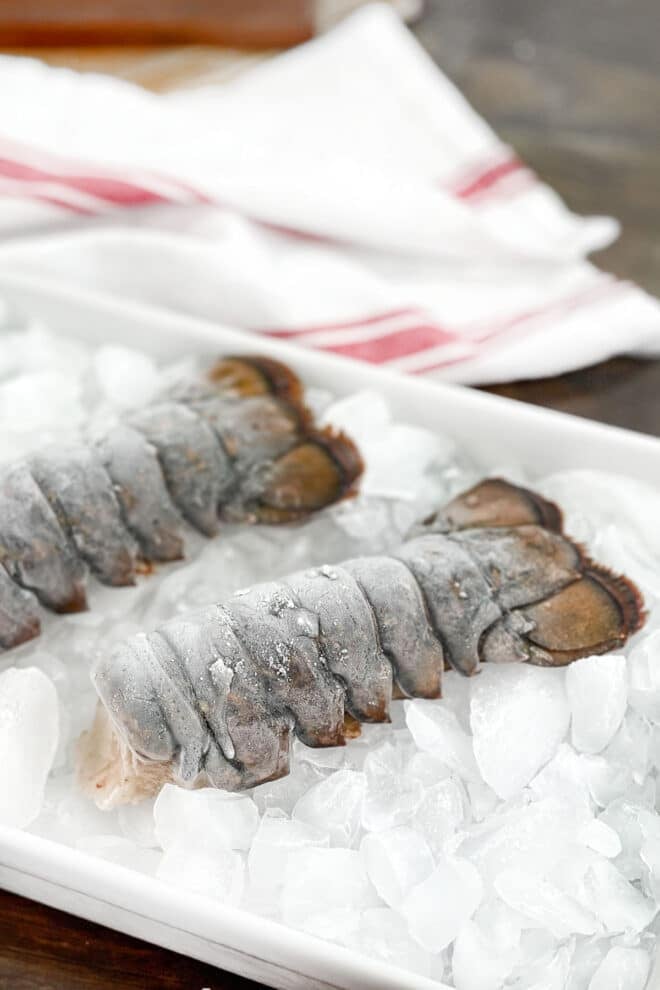
Where To Buy Lobster Tails
You’ll most always find the best price at your local fish monger. If you don’t have one nearby, wholesale food clubs and local grocery stores will often carry frozen tails at the seafood counter or in the frozen food section. If you don’t see them, ask. Because lobsters are expensive, some grocery stores keep them in the large walk-in freezer behind the counter to prevent theft.
You can also order frozen lobster tails online, but check prices because they vary greatly. Popular steak and seafood mail order companies tend to have higher prices than other online specialty markets.
You might also find thawed lobster tails at the grocery store or fishmonger. I don’t recommend buying these because you never know how long they’ve been sitting in the case. Fresh is the key when it comes to lobsters! You always want to take them home alive, frozen, or already cooked. In the case of lobster tails, frozen is the best option.
Lobster tails are available as cold water and warm water varieties. Cold water lobsters are caught in the cold waters of the Atlantic Ocean in places like Canada, Maine, and coastal New England. Warm water lobsters are caught off the coast of Florida, the Caribbean, California, and similar tropical or areas with warmer waters. Sizes vary greatly, but are typically available between 4- and 8-ounce tails.
How To Thaw Frozen Lobster Tails
Since I found that you do indeed need to thaw them first, I tested two ways to thaw the lobster tails: cold running water and refrigeration. I prefer letting them thaw in the refrigerator for a couple of reasons. Although it takes a little longer (but not by much), it’s the safest way to thaw seafood.
Thawing in running water can introduce unwanted water into the cut-end of the tail that could interfere with cooking. Thawing in the refrigerator prevents this. You can expect the tails to take a few hours to thaw in a cold fridge, so I usually let them sit on a sheet pan in the fridge overnight.
Once I ruled out cooking the frozen tails directly from frozen, and found the best way to thaw them, I tested multiple methods of cooking them to see which truly produced the most tender and flavorful lobster meat.
What’s The Best Method To Cook Lobster Tails?
While boiling, broiling, and roasting all worked, poaching resulted in the most tender lobster. Just as important, it allowed for the maximum aromatics and flavors to be added. The other methods not only took longer, they also didn’t give much opportunity to flavor the lobster meat, except on the outside. In addition, with roasting and broiling, the tails aren’t in the oven long enough to impart any “roasted” flavor. Plus, any meat that was exposed to the hot oven air became dry and chewy.
You can also check out this method for Lobster Tails on the Grill for something a little different.
Low, slow, gentle heat keeps the lobster meat tender, which is why poaching is the best option for the tails. And since poaching involves gentle cooking in liquid, the liquid can be flavored with anything you’d like.
How To Cook Lobster Tails
Preparing Your Thawed Lobster Tails
To get the most flavor into the lobster tails while poaching, I first cut away the middle undershell with clean kitchen scissors, exposing the meat to allow flavors to seep into it. Cutting this part away also helps make eating the lobster tails at the table a lot easier, and makes it easy to remove the tail meat in one piece. It also keeps the pretty red shell intact for presentation. (See video below.)
Video: How To Trim Away Lobster Undershell Before Cooking
Before cooking begins though, you’ll want to insert a wooden skewer into the tail to keep it from curling up into a ball while cooking. Because the under-shell has been removed, it’s a lot easier to see where the skewer is going. Insert the skewer into the “top” of the lobster tail where it was cut before it was packaged, and push the skewer all the way to the tip of the tail. Cut off any excess skewer so the lobster can still fit into the pan. The skewer also helps the lobster tails to cook evenly by keeping them straight.
Flavoring Your Poaching Liquid
Once the tails have been skewered, set those aside and prepare the poaching liquid. In this case, it’s butter, and lots of it, with garlic and herbs. Not only is the butter infusing flavor into the lobster, but the lobster will also impart its flavor into the butter. After poaching, the lobster-infused butter can then be used for dipping or saved in the fridge up to 5 days for other recipes. The butter can also be frozen up to two months.
You can add other aromatics to the pan as well. Some of my favorite combinations are sliced fennel bulb and a splash of vanilla extract, chipotle in adobo and lime zest, and onion, bay leaf, green bell pepper, and coconut milk.
Poaching Lobster Tails in Butter
In a straight-sided skillet or wide saucepan (the pan should be wide enough to place the lobster tails flat in the pan), add the butter, garlic, thyme, salt, and pepper. Cook this on low heat, swirling the pan every now and then until the butter is completely melted. You might start to see some white solids in the pan. This is just the milk solids beginning to separate and is perfectly normal – it won’t affect the flavor. However, do not let the butter boil or it will turn into browned butter, and as the lobster cooks, it can start to get bitter.
As soon as the butter has melted, add the lobsters, cut-side-up, and baste the exposed tail meat with the pan butter. Cover the pan and poach for 10 minutes or until the internal temperature of the lobster meat registers 135°F, or 140°F for a firmer texture, on an instant-read thermometer. It’s important the butter never boils, so check by listening or removing the pan lid and adjusting the heat as needed.
Transfer the lobster tails to a serving platter or to plates and serve immediately with some of the melted butter from poaching.
What About The Leftover Butter?
It takes a lot of butter for the poaching, so the leftover butter can be transferred to a glass or ceramic container. Store in the refrigerator, covered, up to five days, or in the freezer for up to two months. It can stay frozen for longer, but I’ve found that, even if covered well, the butter tends to take on flavors and smells from the freezer.
That butter is going to be infused with thyme and with lobster flavor. You can use it to poach more frozen lobster tails at a later date, or to poach shrimp, or as a dipping sauce or drizzling sauce for seafood. It’s also amazing on asparagus and green beans, and also mixed with rice before cooking it. When I cook lobster tails in butter this way, I actually divide the butter into 8 portions afterwards. I keep 2 in the fridge to use in the days ahead, and the remaining 6 go into the freezer for using later on.
Save the lobster shells, too! You can store them in a zipper bag in the freezer for up to a year. The shells can be used to flavor seafood soups, bisques, stews, and sauces.
More Amazing Seafood Recipes
You can browse my full collection of seafood recipes, or try one of these great favorites.
- How to Cook Frozen Scallops
- Pan-Roasted Salmon
- Best Shrimp Boil Recipe
- Air Fryer Fish from Frozen
- Perfect Fish Fillets Recipe
- Spicy Mussel Soup
Podcast Episode: Cooking Frozen Lobster Tails
Listen to me explain briefly about how to make lobster tails, along with some other great tips, by clicking the play button below:
Listen to more Recipe of the Day episodes here.
Print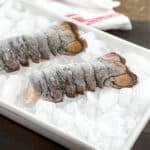
How to Cook Frozen Lobster Tails Recipe
- Prep Time: 15 minutes
- Cook Time: 25 minutes
- Total Time: 40 minutes
- Yield: 2 servings 1x
- Category: Entrée
- Method: Stovetop
- Cuisine: American
DESCRIPTION
After thawing in the refrigerator for a few hours or overnight, frozen lobster tails are best prepared by poaching in butter. Here’s how.
Ingredients
- 4 (4 oz.) frozen lobster tails, thawed
- 3 lbs. salted butter (12 sticks)*
- 6 garlic cloves, peeled, smashed
- 1 and 1/2 tsp. fresh thyme leaves
- 1 tsp. salt
- 1/4 tsp. ground black pepper
Instructions
- Working with one lobster tail at a time, place tail on a cutting board with tiny feet facing up. Using sharp kitchen sheers, cut the undershell from tip to tail along the right side where the hard top shell meets the undershell. Repeat with left side. Remove the center portion of the undershell, exposing the tail meat. Repeat with remaining lobster tails, see video above. **
- In a straight-sided skillet or wide saucepan that is just big enough to fit the lobsters in a single layer, add butter, garlic, thyme, salt, and pepper. Cook on low heat, swirling pan occasionally until butter is melted, about 10 to 15 minutes..
- Place lobsters, cut side up, in butter mixture. Baste exposed tail meat with butter.
- Cover pan, cook 10 minutes, or until internal temperature of lobster tails register 135°F, or 140°F for a firmer texture on an instant-read thermometer.
- Transfer lobsters to serving plates or platter. Serve immediately with poaching butter.
Love this recipe? I’d appreciate it if you could scroll down and add a *5 star rating* to help others know they’ll love it as well!
Notes
*Note though that the butter is just used for poaching and can be re-used after the lobster tails are cooked. After the cooking is finished, transfer the butter to a sealed container and store it in the fridge for up to 5 days or the freezer for 2 months. It’s going to be infused with the thyme and lobster flavor. You can use it to poach more frozen lobster tails, or some shrimp or as a dipping sauce or drizzling sauce for seafood. It’s also amazing on asparagus and green beans, and also mixed with rice before cooking it. When I cook lobster tails in butter this way, I actually divide the butter into 8 portions afterwards. I keep 2 in the fridge to use in the days ahead, and the remaining 6 go into the freezer.
**If desired, after step 1, insert a wooden skewer through the tail meat to keep it from curling during cooking.
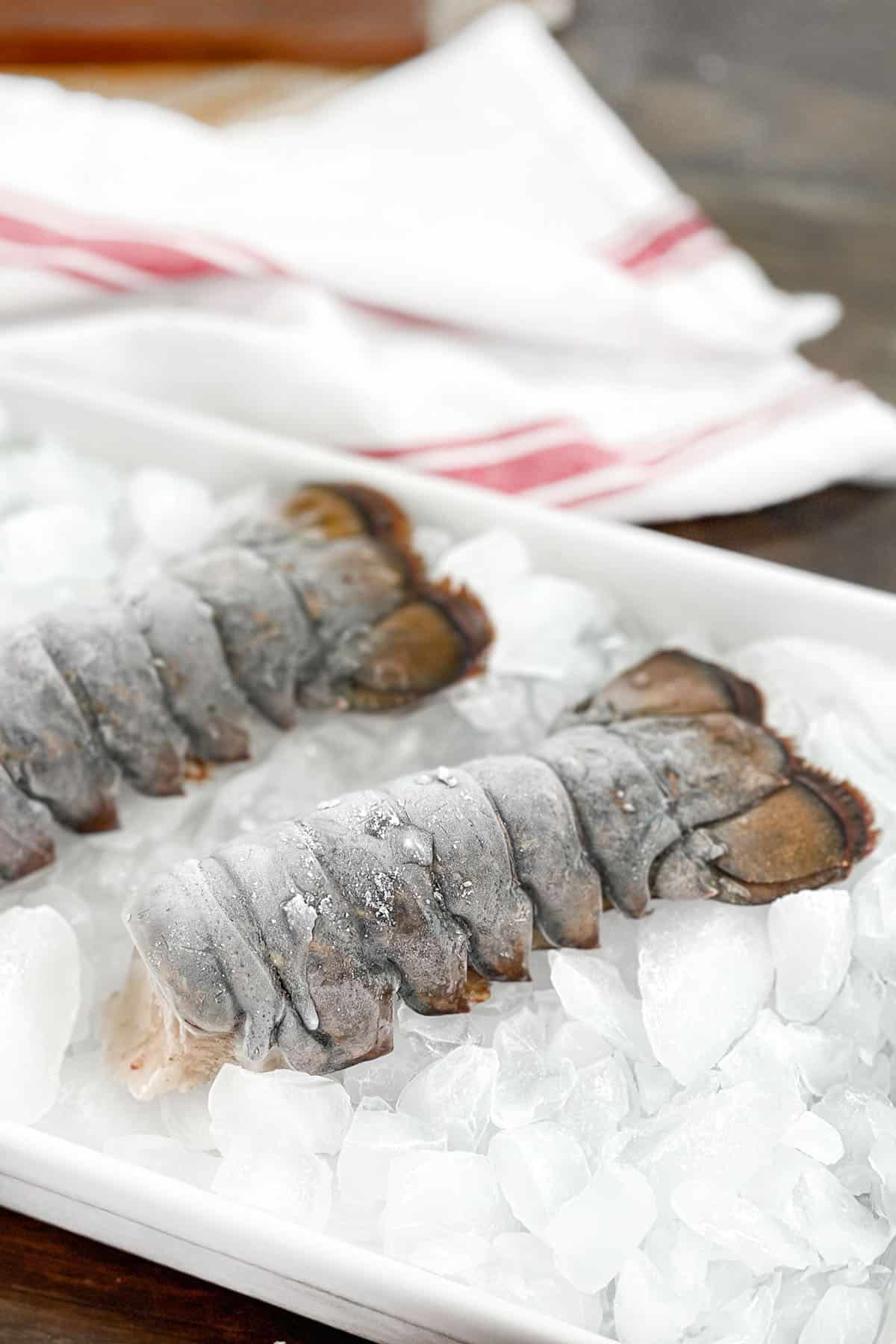

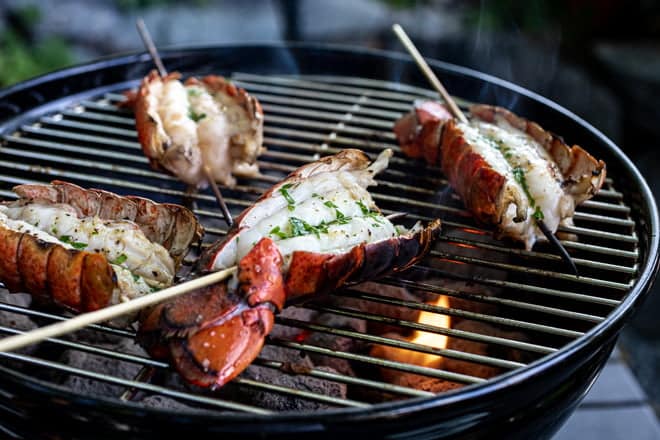
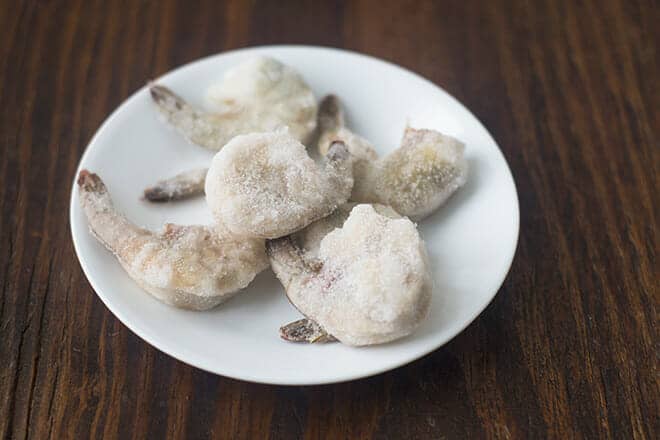
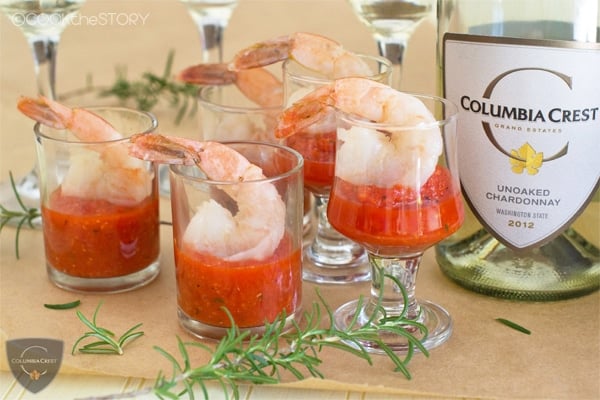
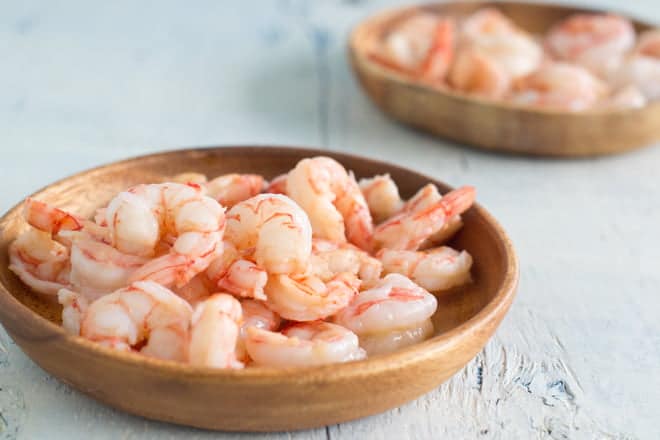



















12 sticks of butter? For four small lobster tails? Yikes.
Leslie, I know it seems crazy. We tested a bunch of different ways to cook the frozen lobster tails and this was the best. Note though that the butter is just used for poaching. If you see above here: https://cookthestory.com/how-to-cook-frozen-lobster-tails/#What_About_The_Leftover_Butter after the cooking is done, you can transfer the butter to a sealed container and store it in the fridge for up to 5 days or the freezer for 2 months. It’s going to be infused with the thyme and lobster flavor. You can use it to poach more frozen lobster tails, or some shrimp or as a dipping sauce or drizzling sauce for seafood. It’s also amazing on asparagus and green beans, and also mixed with rice before cooking it. When I cook lobster tails in butter this way, I actually divide the butter into 8 portions afterwards. I keep 2 in the fridge to use in the days ahead, and the remaining 6 go into the freezer. I hope this helps it to make more sense! I’m actually going to add a note to the recipe since right now the info about storing the butter is higher up and people might not see it there and might only see the 3 pounds of butter and be shocked.
I am an 82 year old widow whose husband did most of the elegant cooking. I had never prepared lobster on my own. I bought a lobster tail on sale yesterday, and followed your directions. It worked as you promised, and I enjoyed my New Year’s Eve dinner date with myself last night!
Marnie, I’m so happy to hear that it turned out for you. Thank you for coming back to let me know. And I hope you have a wonderful 2024! :)
Followed the recipe as stated. All I can say is it was the best lobster tails I have ever had. I have never had such tender lobster. I did save the butter from poaching and used it for shrimp…..it was so delicious. This recipe will not disappoint.
Thank you so much, Sharon! I’m thrilled you enjoyed it.
Delicious, succulent and tender! Had two small tails and used 1 stick of butter and the garlic and thyme; added some shrimp and served with a vegetable & fine noodle side. This is a winner; thank you!
That sounds AMAZING, Robbie! Thanks for sharing with us how you served them, I love to hear that.
Just bought some to make for Valentines Day for a surf and turf for me and my hubby I made these before for New Years eve and they came out amazing. I did not use the amount of butter though. I used 1 stick butter for 2 tails and it worked perfectly. We also served with lemon on the side as we enjoy that. THANKS
You’re welcome, Mary Ann! I’m so happy you liked it!
This was absolutely amazing! I never thought I could cook lobster like a gourmet chef! My lobster turned out better than any seafood restaurant where I’ve eaten. Thank you! It made my New Year’s Eve dinner very special for my husband and me.
Janet, That is so amazing to hear! Happy New Year!